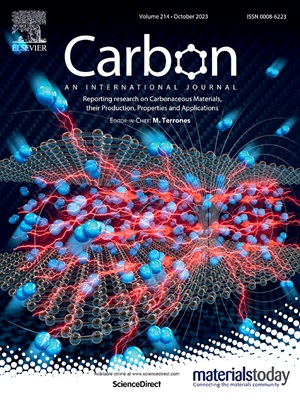Precision-Engineered hard carbon from bituminous coal via small-molecule extraction for high-rate sodium-ion batteries
IF 11.6
2区 材料科学
Q1 CHEMISTRY, PHYSICAL
引用次数: 0
Abstract
The challenge in decoupling the order and disorder phase evolution impedes the precise microstructure control of hard carbon (HC) anodes, fundamentally limiting the reconciliation of high capacity and fast kinetics for sodium storage. Here, we realize a precise modulation of order and disorder structures in HCs using bituminous coal precursors containing inherent aromatic units and aliphatic side chains. By removing the volatile small aromatic species (molecular weight <500 amu) with methanol extraction, more active edges of coal macromolecules (molecular weight >500 amu) and C–O/C![]() O/O–C
O/O–C![]() O functional groups are exposed, which enhances the cross-linking of macromolecules aromatic units, yielding long, curved microcrystalline domains with enlarged interlayer spacing and abundant closed nanopores. The extended carbon microcrystals boost electronic conductivity, while expanded interlayers and closed pores facilitate Na+ diffusion and storage. As a result, the obtained HC has a high capacity of 256 mAh g−1 and long cycling stability (capacity retention of 80.8 % after 1500 cycles) at a very high current density of 2000 mA g−1. This work demonstrates a scalable route for precise structural modulation of coal-derived HC to reconcile capacity and rate performance in sodium-ion batteries.
O functional groups are exposed, which enhances the cross-linking of macromolecules aromatic units, yielding long, curved microcrystalline domains with enlarged interlayer spacing and abundant closed nanopores. The extended carbon microcrystals boost electronic conductivity, while expanded interlayers and closed pores facilitate Na+ diffusion and storage. As a result, the obtained HC has a high capacity of 256 mAh g−1 and long cycling stability (capacity retention of 80.8 % after 1500 cycles) at a very high current density of 2000 mA g−1. This work demonstrates a scalable route for precise structural modulation of coal-derived HC to reconcile capacity and rate performance in sodium-ion batteries.

通过小分子萃取从烟煤中提取精密工程硬碳,用于高倍率钠离子电池
对有序和无序相演化解耦的挑战阻碍了硬碳(HC)阳极的精确微观结构控制,从根本上限制了高容量和快速钠储存动力学的调和。在这里,我们使用含有固有芳香单位和脂肪侧链的烟煤前驱体实现了hc有序和无序结构的精确调制。通过甲醇萃取去除挥发性小芳香物质(分子量>;500 amu),暴露出煤大分子(分子量>;500 amu)和C-O /CO/ O-CO官能团的更多活性边,增强了大分子芳香单元的交联,生成了长而弯曲的微晶畴,层间距扩大,有大量的封闭纳米孔。扩展的碳微晶提高了电子导电性,而扩大的夹层和封闭的孔有利于Na+的扩散和储存。结果表明,在2000 mA g−1的高电流密度下,获得的HC具有256 mAh g−1的高容量和长循环稳定性(1500次循环后容量保持率为80.8%)。这项工作展示了一种可扩展的路线,用于煤衍生HC的精确结构调制,以协调钠离子电池的容量和速率性能。
本文章由计算机程序翻译,如有差异,请以英文原文为准。
求助全文
约1分钟内获得全文
求助全文
来源期刊

Carbon
工程技术-材料科学:综合
CiteScore
20.80
自引率
7.30%
发文量
0
审稿时长
23 days
期刊介绍:
The journal Carbon is an international multidisciplinary forum for communicating scientific advances in the field of carbon materials. It reports new findings related to the formation, structure, properties, behaviors, and technological applications of carbons. Carbons are a broad class of ordered or disordered solid phases composed primarily of elemental carbon, including but not limited to carbon black, carbon fibers and filaments, carbon nanotubes, diamond and diamond-like carbon, fullerenes, glassy carbon, graphite, graphene, graphene-oxide, porous carbons, pyrolytic carbon, and other sp2 and non-sp2 hybridized carbon systems. Carbon is the companion title to the open access journal Carbon Trends. Relevant application areas for carbon materials include biology and medicine, catalysis, electronic, optoelectronic, spintronic, high-frequency, and photonic devices, energy storage and conversion systems, environmental applications and water treatment, smart materials and systems, and structural and thermal applications.
 求助内容:
求助内容: 应助结果提醒方式:
应助结果提醒方式:


